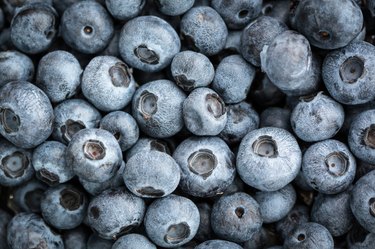
If you have frequent colds and flu, allergies, food sensitivities, recurring urinary tract and yeast infections, a persistent cough, skin problems, constipation, irritability, brain fog or fatigue, you may have candida, according to the Candida diet website. This condition is characterized by the overgrowth of Candida albicans, a fungus that in excess in the body may cause these undesirable effects. The Candida diet is a low-sugar eating plan that bans both added and natural sugars. This means you can't eat any fruit for the duration. Ask your doctor if the Candida diet is right for you.
No Sugar Allowed
Video of the Day
Proponents of the Candida diet theorize that sugar is one of the main causes of candida overgrowth. According to the Candida diet website, candida feeds on sugars; the more sugar available to the cells, the easier and faster they can grow and expand their colonies. For this reason, the Candida diet recommends avoiding sugar of any kind, whether it's from cake, candy and cookies or from a nutritious source like fruit.
Video of the Day
Eating Fruitlike Vegetables
You can't have any type of food normally classified as a fruit. This means no apples, pears, oranges, mangoes, blueberries, kiwis, melons, strawberries, grapes or grapefruit. Any form of fruit -- fresh, frozen, canned or dried -- is off-limits. However, there are a few exceptions, most of them of a technical nature. You can eat foods biologically classified as fruits but commonly considered vegetables. This group includes tomatoes, eggplants, cucumbers, peppers, okra and avocados. You can have a squeeze of fresh lemon juice, according to the Candida diet website, and you can have olives that have not been prepared with white distilled vinegar.
How Long Does the Diet Last?
The point of candida diets is to starve the fungus of sugar so that it dies and comes under control. The Candida diet website explains that this could take a few weeks to several months. Once your symptoms have subsided, you can begin reintroducing healthy foods such as fruits. The website suggests starting with low-sugar fruits such as green apples. If your symptoms don't return, keep adding a range of fruits into your diet.
You May Not Need to Avoid Fruits
There's little evidence supporting the effectiveness of dietary changes in controlling candida. According to the University of Maryland Medical Center, the diet may not actually get rid of candida, but it may improve symptoms because it's a healthy diet that limits the intake of processed foods, added sugars, white flours and other foods that are low in nutrients. However, fruit is a healthy food that's high in fiber and essential vitamins and minerals. Cutting out processed foods and added sugars may go a long way toward improving your symptoms without the need to give up fruit.
- The Candida Diet: Candida Symptoms
- The Candida Diet: What Is Candida Albicans?
- The Candida Diet: The Anti-Candida Diet
- The Candida Diet: Foods to Avoid on the Candida Diet
- The Candida Diet: Foods to Eat on the Candida Diet
- Kitchen Daily: The Most Surprising Fruits Commonly Mistaken for Vegetables
- University of Maryland Medical Center: Candidiasis